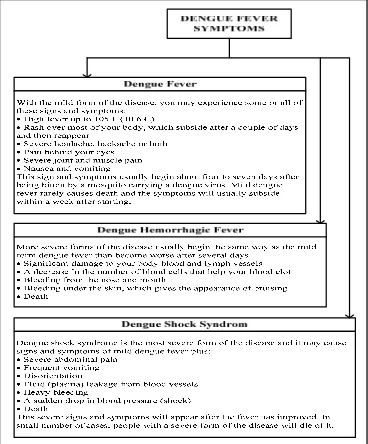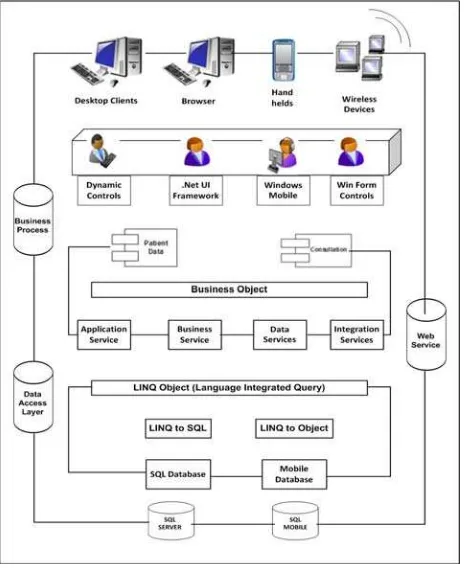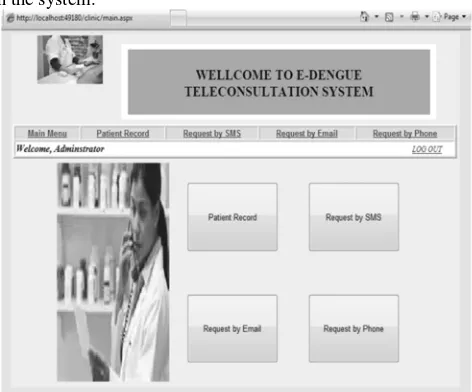Study and Design Framework for e-Dengue
Teleconsultation System
Andik Setyono1, Md. Jahangir Alam2 and Beatrice Ann Maria Soosai3
1
Faculty of Computer Science, Dian Nuswantoro University, Semarang, Indonesia (Tel : +62-24-351-7261; E-mail: [email protected])
1, 2, 3 Faculty of Information Technology, Multimedia University, Cyberjaya, Malaysia
(Tel : +60-38-312-5570; E-mail: [email protected])
Abstract-Information and Communication Technology (ICT) in medical world has been widely used. The telemedicine system will be growing rapidly in accordance with the growth of the ICT. The use of technology can provide an easiness to patient to connect the doctor or nurse for getting medical treatment without visiting the hospital. In this paper, we propose a framework for developing e-Dengue teleconsultation system. It is built to allow the user (patient) to get early concern about the disease and performing teleconsultation via Internet or mobile phone. The developed system is expected to monitor dengue fever outbreak for reducing the number of dengue patient. The proposed framework can be used to develop practical telemedicine systems in future.
Keywords: e-Dengue, healthcare, telemedicine, teleconsultation, dengue fever
I. INTRODUCTION
Telemedicine means that medicine delivered at a distance specifically to transfer the electronic medical data from one location to other using information and telecommunication technologies to provide medical information and services [1]. Telemedicine is the practice of medical care using the interactive audio visual and data communications. This includes the delivery of medical care, diagnosis, consultation and treatment, as well as health education and the transfer of medical data [2]. Teleconsultation is one of the types of telemedicine and it is the provision of consultation services using technology over a geographic distance.
In developed nations, telemedicine and telecare is adopted to get lower costs, increase convenience for patient and improve the quality of treatment. People can use telemedicine for expanding specialist advice. This is different in under developed nations; telemedicine offers the hope of identifying disease at an early stage and leading to the necessary treatment locally. In future, telemedicine will include growing telemedicine into the mainstream to develop health policy and strategy by exploiting the Internet, and enhancing healthcare in underdeveloped countries [1].
In this paper, we focus on the development of e-Dengue teleconsultation system as a case study in Malaysia. We develop e-Dengue teleconsultation system case in Malaysia because Malaysia has higher case fatality rates (4.67%)
compared to the neighboring countries like Thailand and Indonesia, with the case fatality rates 0.3% and 0.5% respectively [3].
The main goal of this research is to develop and implement e-Dengue teleconsultation system that allows the citizen and doctors of Malaysia to interact and exchange information related to dengue fever. The consultation will be conducted via the built web site. It can be used as a primary care to follow up consultation. This system facilitates between consultant (doctor) and patient including (i) entering patient’s current medical data (health status), (ii) allowing the patient and the consultant to exchange information in real-time concerning about the current condition of the patient and (iii) the patient’s agreement to use the on-line service after first face-to-face consultation with the consultant. The developed system is expected to assist and ease the dengue monitoring and predicting the dengue outbreak cases in Malaysia.
The remaining part of the paper is organized as follows: section 2 presents the literature review. The methodology and proposed framework is presented in section 3, design of e-Dengue teleconsultation system is presented in section 4. Evaluation and analysis is presented in section 5 and conclusion is presented in section 6.
II. LITERATURE REVIEW
A. The Telemedicine System
According to World Health Organization (WHO), Telemedicine is the practice of medical care using the interactive audio visual and data communications. This includes the delivery of medical care, diagnosis, consultation and treatment, as well as health education and the transfer of medical data [4]. Telemedicine is also primarily concerned with improving the accessibility and quality of healthcare. The essential component of delivering an effective care is to access accurate and valid information. This information originates from many sources and is recorded in many different formats, such as the simple data (text) to more complexes (multimedia) [4]. The telemedicine system needs three essential components: a. Devices for information input:
moving images (video). Each type of information may require a specialized input device.
b. Means of information transport:
Once the information has been captured, it is needed to transmit to the other end of the telemedicine link. For example, a telephone call needs a telephone circuit to be established between the two parties.
c. Devices for information display:
After the information has been transmitted to the remote party, it is needed to be display. For example, in the case of telephone call, the ‘display’ is the loudspeaker in the telephone handset. Moreover, much of the information in telemedicine is in visual and is often displayed on various kinds of television screen or computer monitors [4].
B. Types of Interaction
In a telemedicine system, there are two types of interactions. The first one is the ‘Store and Forward’ and the second one is the ‘Real-Time’. The ‘store and forward’ also known as “pre-recorded” or “asynchronous”, where the information is exchanged between two sites is stored and then forwarded to the recipient or the data is retrieved by recipient. Common examples are the transmission of medical data using email, SMS, MMS and HTTP. In ‘real-time’ interaction, the information is provided in real-time. Both parties will be able to interact at once. A typical example would be a videoconferencing between a nurse in a minor injuries unit at a community hospital and a consultant at a major accident and emergency unit. Table 1 shows the comparison between store and forward and real-time telemedicine interaction [5].
TABLE I
COMPARISON BETWEEN STOREAND FORWARD AND REAL-TIME TELEMEDICINE INTERACTION [5]
Description Store and Forward Real Time
Cost Cheaper More expensive
Work for General
Bandwidth Low High
Type Of
Real time but less convenient for nor interact with the consultant
Convenience and can interact with consultant
Main Example Dermatology Treatment of minor injuries
C. Overview Teleconsultation
Teleconsultation is the provision of consultation services using technology over a geographic distance. The level of teleconsultation success depends on the number of users, speed of services, costs and the extent of accessibility to the homes of individual. Many health professionals and non-government organizations use teleconsultation for a range of purposes including for basic consultancy, preliminary diagnosis,
supporting, monitoring, case management and rehabilitation [6].
The concept of mobile consultations is not new, but it has picked significant steam with the mass adoption of smart phone over the past few years. The 3G or 4G technology has made doctor’s consultation mobile much more natural and seamless. The use of mobile consultation ranges from medical references tools for provider to remote physician consultation from consumer’s mobile phone. In coming years, mobile consultation will be viewed as a mainstream method of seeing the doctor. In fact, research shows that two-third of physicians in America used smart phones in 2009, and the numbers are expected to reach 81% by 2012 [7]. Thus, it will not be surprising that in coming years the physicians will have the potential to be tremendously in mobile. This will provide the opportunities to increase productivity, revenue and lifestyle satisfaction whereby the physician will be less tied down to a location [8].
We have compared between teleconsultation and face to face consultation to know the advantages and disadvantages. In face-to-face consultation, the patient will have greater satisfaction seeing the doctor and getting the necessary consultation. For some doctors, they read patient’s gestures and expression for diagnosing the disease. The disadvantages of face-to-face consultation are the patient have to travel to get the consultation and there is no guarantee the consultant will be done in time. Even though, the patient reaches at the hospital on time, he/she may have to wait in the queue for long time. Thus, this increases the waiting time.
The advantages of the teleconsultation that are reducing the need for outpatient consultation, the travel by the patient, their careers and hospital staffs and also wait time in queue at the hospital, increasing in patient and career confidence in managing their condition at home and improving their well-being, improving the outcome of continuous medical education. Furthermore, the disadvantages of teleconsultation are delay in transmission between sites which makes remoteness of participants apparent, it is not rich as face to face meeting, it is not suitable for emotionally charged discussion and it is not efficient in having the meeting with diverse and conflicting standpoints.
III. METHODOLOGY AND PROPOSED FRAMEWORK
A. Problem Identification
begins abruptly and will be followed by 3 phases: febrile, critical and recovery phase [9].The total dengue cases reported for week 36/2010 (05-11 September 2010) is stated as follow:
TABLE II TOTAL DENGUE CASES REPORTED
Note: ( ) Total Deaths
The system will be used for the patient with dengue fever, dengue haemorrhagic and dengue shock syndrome and other severe dengue. It is also applicable to primary care doctors, public health personal, nurses, assistant medical officers, physicians and critical care providers involved in treating the patient with dengue fever. To know and understand the dengue fever, we present the criteria of dengue fever symptoms. It is used to determine the patient with dengue condition. Fig. 1 shows the dengue fever analysis.
Fig. 1. Dengue fever symptoms analysis
B. Proposed Framework
In this research, we propose a framework consists of prediction model, Dengue teleconsultation model and e-Dengue teleconsultation architecture. Prediction model is described that the main objective of scientific theories is to produce “prediction” about observable events [10]. Prediction model is used to show the system in query data process from database server and then reply the data that is required by user. The expert database will provide the possible prediction or interpretation about the health status of user. Fig. 2 describes the proposed prediction model.
Fig. 2. Proposed prediction model
This research is majorly focused on producing the e-Dengue teleconsultation system. Fig. 3 describes the proposed e-Dengue teleconsultation model.
Fig. 3. Proposed e-Dengue teleconsultation model
In Fig. 3 shows that the dengue patient can agree to use the online service. A user (doctor, patient, nurse) can login in the system and get the related dengue fever record for patient in
State Total Death Cases Reported
Accumulated Total of Dengue Case
till week 36/2010
Accumulate d Total of Dengue Case
till week 36/2010 Week 36
(5-11 Sept 2010)
Week 35 (29-04 Sept 2010)
Perlis 5 9 137 161
Kedah 6 13 571 (3) 613
Pulau Pinang 54 66 1,064 (3) 1,926
Perak 41 58 1,667 (5) 2,431 (1)
Selangor 186 236 13,358 (38) 15,040 (44)
KL&Putrajaya 55 51 3,334 (5) 2,892 (8)
Neg. Sembilan 9 9 1,359 (7) 670 (5)
Melaka 36 43 821 (10) 610 (2)
Johor 114 149 (1) 2,913 (9) 1,880 (3)
Pahang 16 30 1,064 (1) 655 (2)
Terengganu 57 (1) 42 769 738
Kelantan 214 307 2,531 (9) 873 (1)
Sarawak 67 77 3,445 (13) 1,317
Sabah 38 54 1,681 (1) 760 (3)
WP Labuan 0 0 16 22
order to update. Patient will be able to send the details about their health condition (fever temperature, blood countlevel and other symptoms) in the form of multimedia files using SMS or email. The multimedia message will be sent by the patient to doctor via hand phone and the doctor will receive the alert message to view the patient health status record. Once, the doctor is at the workstation, the doctor can access the e-Dengue system to view the dengue patient record and give advice to the patient current health status. Based on the advice given by the doctor, the patient must co-operate along to get the necessary medication and follow all the medical treatment at the nearest hospital is required. The e-Dengue database will also contain the current dengue patient record and as well as the old record of dengue patient. The records can be used to predict about the dengue disease patterns and its environment. Based on the current reported dengue cases, the doctor can retrieve the reported dengue cases count and it is aligned based on the states.
We also propose e-Dengue teleconsultation architecture. We use Microsoft Visual Studio 2008 to develop e-Dengue teleconsultation system application. Fig. 4 describes the proposed e-Dengue teleconsultation architecture.
Fig. 4. Proposed e-Dengue teleconsultation architecture
The proposed system is used by Malaysian citizen who are patients with dengue fever, dengue hemorrhagic fever, dengue shock syndrome or other severe dengue. It is also applicable primary care doctors, public health personnel, nurses, assistant medical officers, physicians and critical care providers involved in treating the patients with dengue fever.
The tool which is developed for the system is software-based and web-software-based. Software-software-based tools must be installed on each computer prior to using the tool. For the use of web-based tools, access to the internet is required. The shortcomings of the currently available tools have made the use of mobile devices more appealing. In mobile computing, the issues such as low bandwidth, high latency wireless network, loss or degradation of wireless connections, and network errors or failures need to be solved. Other issues are addressed including system adaptability, reliability, robustness, extensibility and maintainability.
C. Design of e-Dengue Teleconsultation System
The dengue fever status check has been coded in Microsoft Visual Studio 2008. This section will allow the public to check their health status and confirm themself whether they are having dengue fever. Fig. 5 describes the proposed system flow.
Fig. 5. Proposed design of e-Dengue teleconsultation system application
After the consultation the doctor can update the patient record in the system.
Fig. 6. Design e-Dengue teleconsultation system application
IV. EVALUATIONAND ANALYSIS
In this paper, we propose a framework for e-Dengue teleconsultation system application. We are interested for exploring telemedicine for developing e-Dengue teleconsultation. It is because monitoring dengue fever is still slightly. For an example in Malaysia, monitoring dengue still use via telephone and email updates based on the types disease reported daily and manually. The patient record from all hospital can be accessed by medical officer on duty from integrated database.
We use mobile phone to send patient data (multimedia) using SMS and email to the system. The patient data such as fever temperature, blood preasure and other symptoms information. The system will give alert as notification to the doctor to inform that the patient needs to consult. Besides that the patient can open website for e-Dengue teleconsultation to open the system and input the data or chat with the doctor on duty and available online. It will help the patients to know the status whether they have dengue fever or not. It can reduce the number of deaths from dengue patients because the patients can take treatment and consultation with the doctor properly.
The system is developed using Microsoft Visual studio and Windows Mobile Framework by using Windows operating system platform. This is a prototype system. The softwares used are only tools. We can migrate to use open source programming and operating system so that the system will be more efficient. The shortcomings of the currently available tools have made the use of mobile devices more appealing. In mobile computing, the issues such as low bandwidth, high latency wireless network, loss or degradation of wireless connections, and network errors or failures need to be dealt with. Other issues to be addressed including system adaptability, reliability, robustness, extensibility and maintainability.
We can also use mobile messaging system such as Multimedia Messaging System (MMS) to send multimedia data to the system. The development of the MMS technology on the mobile phones is very complex. This is different with the development system on the personal computer because we can use bigger memory in accordance with the system need. The use of MMS technology to send patient data will generate the efficient system. This is because the use of MMS technology is same like SMS technology. The user is commonly more familiar using messaging system than making Internet connection on mobile devices. The site will appear small, difficult to move and difficult to read. This concept will be investigated to get an adaptive and efficient MMS framework for internet application. The research will be performed in the future research.
V. CONCLUSION AND FUTURE WORK
In medical service, the quality of health information and the speed with which it is delivered pay a significant role towards the end. The use of information telecommunications and multimedia technologies in providing healthcare will provide the potential to enhance patient care. In summary, the healthcare is all about knowledge management. Good healthcare requires the right knowledge being available at the right time in the right place, and this will provide the right result.
The proposed framework is implemented on e-Dengue teleconsultation system application. It can be used to build other system for different diseases. We hope e-Dengue teleconsultation system will be beneficial to monitor the dengue efficiently. For future work, we will improve the framework to handle teleconsultation widely specially for mobile telemedicine system.
REFERENCES
[1] C. Norris, “Essentials of Telemedicine and Telecare,” John Wley & Sons, Ltd, 2002.
[2] Kementerian Kesihatan Malaysia, http://www.moh.gov.my [online]. [3] N. A. Husin, N. Salim and A. R. Ahmad, “Simulation of Dengue
Outbreak Prediction,” University Teknologi Malaysia (UTM), Johor, 2006.
[4] R. Wootton, J. Batch, “Telepediatrics: Telemedicine and Child Health,” The Royal Society of Medicine Press Limited, August 2004.
[5] K. Doughty, “Telemedicine Communication Channels-Wired Links,” Journal-Technology In health Care, United Kingdom, pp. 48-51, 2002. [6] T. Lee, “Medical Education and the Internet: This Changes Everything,”
JAMA, Vol.285, No.6, 2001.
[7] G. Kaur and N. Gupta, “E-Health: A new Perspective On Global Health,” Journal of Evolution & Technology, Vo.15, 2006.
[8] A. Keselman, R. Logan and C. Arnott, “Developing Informatics Tools and Strategies for Consumer-centered Health Communication,” Journal of the American Medical Informatics, Vo. 15 No. 4, 2008.
[9] CPG Secretaria, Health Technology Assessment Section, Ministry Of Health Malaysia, Clinical Practice Guidelines, “Management Of Dengue Infection In Adults,” 2nd Edition, 2008.


